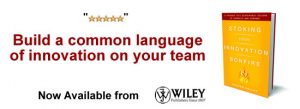Innovative Thinking and Defensive Driving
 Whenever I talk about the importance of innovative thinking, I can count on someone arguing that while we should be creative and explore new ideas, that needs to be balanced with what we already know how to do. We should follow established business processes I’m told and then shift to innovative thinking as needed, when we encounter a problem or when current practices no longer work. They want me to tell them when they should make that shift.
Whenever I talk about the importance of innovative thinking, I can count on someone arguing that while we should be creative and explore new ideas, that needs to be balanced with what we already know how to do. We should follow established business processes I’m told and then shift to innovative thinking as needed, when we encounter a problem or when current practices no longer work. They want me to tell them when they should make that shift.
I tell them: How about right now? Problems and breakdowns are certainly appropriate times to become innovative, but they can also be a little late, and the way we drive (or should drive) is a good analogy.
Few environments are any more rule-bound than a modern highway or intersection. Drivers are expected to stay in their lane, signal turns, observe the speed limit, stop at red lights and so forth. Those rules have been created to keep us safe. Yet most drivers would agree that even when we’re careful to follow all of those rules, we’re not really as safe as we could be. We also need be constantly on the alert for sudden changes that may violate those rules, a truck veering out of its lane perhaps, an inattentive pedestrian, or the car ahead of us making a sudden stop.
From the time we first earn our license, we’re taught to drive defensively, to always be alert to the unexpected. We’re urged to anticipate problems that might occur, because when we become too accustomed to seeing things only in predictable ways, we may not be prepared to make quick emergency maneuvers when we need to. If we’re not paying careful attention and thinking ahead, we may not even notice threats to our safety until it’s too late.
The same thing is true on the job and inside organizations. Routines, no matter how well designed, breed complacency and complacency creates resistance to change. They gradually rob us of our mental agility. Great innovators are those who can see problems coming, who have a heightened sense of awareness and possibility. This is not just an on demand capability, but a sustained frame of mind. They’re proactively looking for potential improvements they can make and problems they can avoid.
Traffic circles are making a comeback in U.S. cities. Instead of stoplights and turn lanes and crosswalks, drivers are expected to merge seamlessly in and out of these “roundabouts.†Studies have found that in many locations these circles are safer than more controlled intersections partly because the rules of the road are more ambiguous. When it’s not entirely clear who has the right-of-way and who doesn’t at any moment, drivers and pedestrians become more alert and cautious and courteous. Rather than assuming that everything around them is predictable and under control, they slow down and do more active scanning to see what’s happening.
Likewise, many organizations would be well-served by loosening things up a little in thoughtful ways. You don’t want people falling into a predictable pattern that assumes that everything is just fine. You want them to feel like a driver entering a traffic circle: a little less comfortable so they’re actively thinking about what’s happening around them, and how to safely navigate the situation to reach important objectives.
You can’t always tell whether someone is driving defensively simply by observing them. Because what changes isn’t necessarily the way they drive as much as the way they think about their driving, the way they process what’s happening around them. In a similar way, having an innovator mindset doesn’t necessarily require that we do our job differently, but rather that we think about it differently. We still need to get the job done, but ideally we should always be pursuing ways to do it better. That’s an innovator mindset.
Don’t miss an article (2,800+) – Subscribe to our RSS feed or join us on LinkedIn or Facebook.
 Dennis Stauffer is the award winning author of Thinking Clockwise, A Field Guide for the Innovative Leader and the Innovator Mindset blog. He’s the founder of Insight Fusion, working with individuals, teams and organizations to boost their capacity to innovate.
Dennis Stauffer is the award winning author of Thinking Clockwise, A Field Guide for the Innovative Leader and the Innovator Mindset blog. He’s the founder of Insight Fusion, working with individuals, teams and organizations to boost their capacity to innovate.
NEVER MISS ANOTHER NEWSLETTER!
LATEST BLOGS
The Evil Downside of Gift Cards
This past holiday season I saw probably one too many articles trumpeting the value of gift cards to retailers and how they are a great thing for retailers. My skeptic side starts coming out as I see article after article appear, and I have to start asking “Is the increasing prevalence of gift cards as a holiday gift (primarily Christmas) a good thing for retailers?”
Read MoreWhy the iPhone will not succeed – Yet
The new Apple iPhone is set to launch on June 29, 2007 and the press and investors are making it a darling. Investors have run Apple’s stock price up from about $85 per share before its announcement to $125 per share recently, but the iPhone still will not succeed – at least not yet.
Read More




Great article and a very good metaphora comparing “be alert” and driving with less rules…